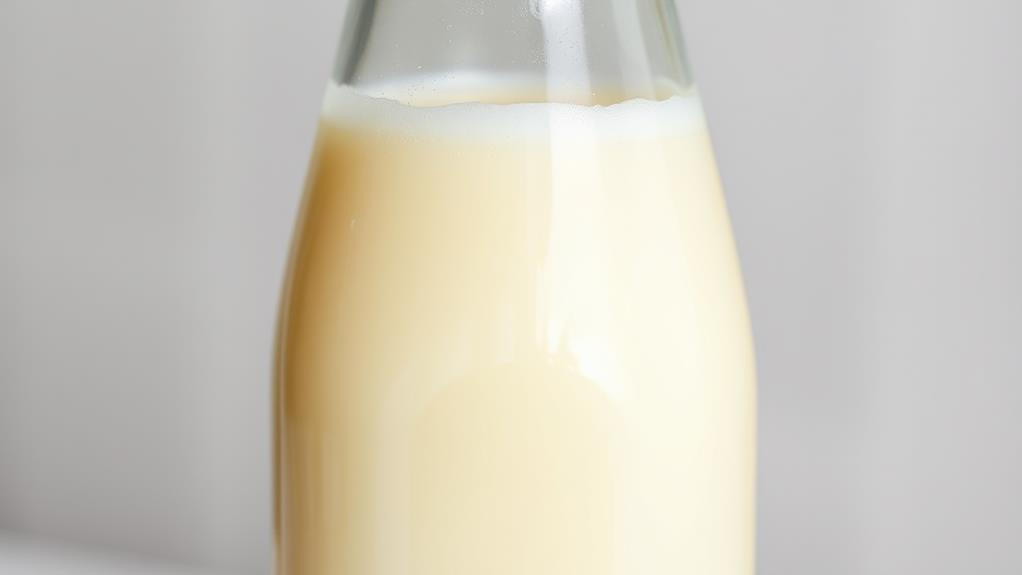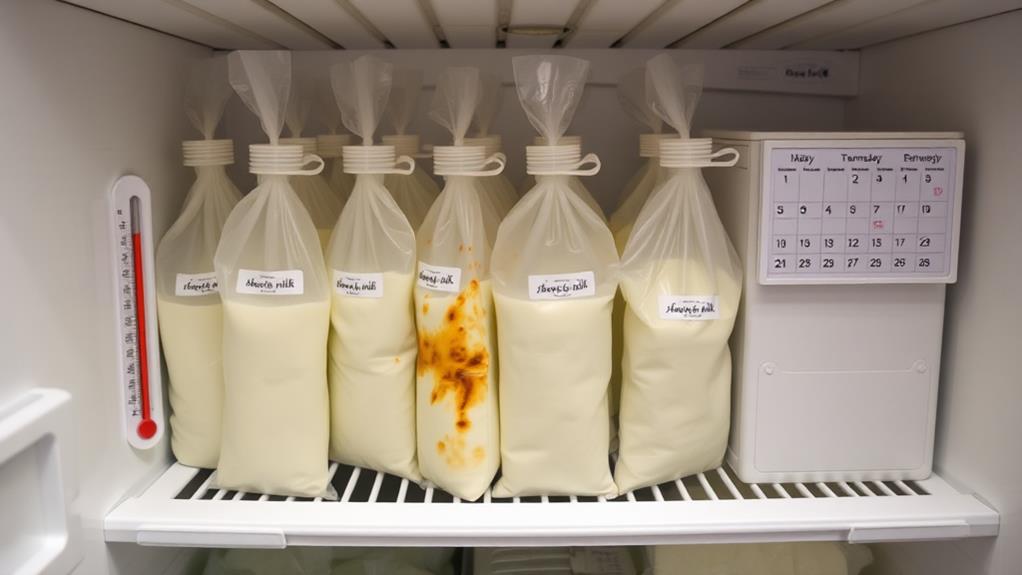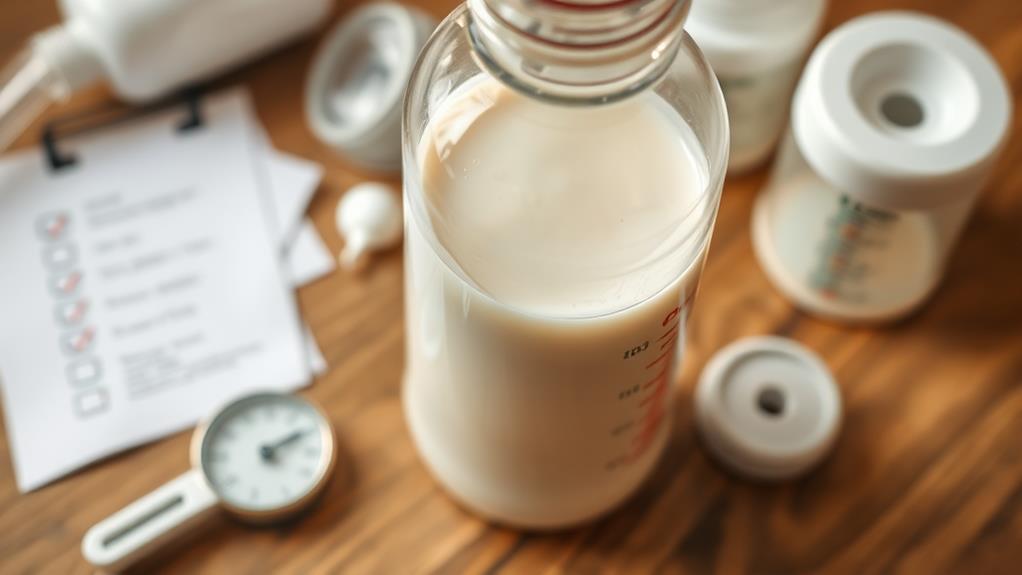When you're breastfeeding or pumping, it's essential to know how to spot bad breast milk to ensure your baby's health. You might notice signs like separation, unusual color, or an off-putting smell that can indicate spoilage. It's not just about what you see; you also need to pay attention to your baby's reactions. If they seem fussier than usual or have digestive issues, it could be linked to the milk quality. Understanding the proper storage techniques can also play a vital role, but there are more nuances to consider that could help you maintain milk integrity and your baby's well-being.
Signs of Spoiled Milk

When it comes to ensuring your baby's safety, being able to spot signs of spoiled breast milk is crucial. You want to make sure your little one gets only the best, right?
One of the first things you should do is a quick visual inspection. If you see any chunky texture or separation into layers, it's a clear sign the milk has spoiled and should be tossed.
Next, pay attention to the smell. If the milk has a sour or rancid odor, especially if it's strong and unpleasant, it's definitely not safe for your baby. Remember, freshly expressed milk mixed with older milk can sometimes hide these off-smells, so always check each batch individually.
If your baby starts spitting up more than usual or seems to have a tummy ache after feeding, it might be due to spoiled milk. It's super important to trust your instincts and be proactive about breast milk storage.
Always conduct that visual inspection and smell test before feeding. Spoiled milk isn't just a waste; it could upset your baby's tummy, and nobody wants that!
Stay vigilant, and you'll keep your baby safe and happy.
Smell and Taste Indicators
Focusing on smell and taste indicators can help you determine if breast milk is still safe for your baby. Fresh breast milk should smell sweet or a bit soapy, which is a good sign. However, if you catch a rancid or sour odor, it's time to say goodbye to that milk—it's spoiled!
Now, if you notice a soapy, metallic, or even fishy smell, don't panic just yet. This could be due to high lipase levels, which mightn't mean the milk is spoiled but can make it taste a bit off.
Speaking of taste, a sour or rancid flavor is a definite red flag for spoiled milk. High lipase milk may taste soapy or metallic, but it can still be safe for your little one.
Keep in mind, when you freeze and thaw milk, these smell and taste changes can become more noticeable. So, it's a good idea to taste test after storage.
If your baby refuses to drink it, it could mean it's not up to snuff. Trust your senses—they're your best friends in this!
Visual Inspection Techniques

To ensure your breast milk is safe for your baby, it's essential to conduct a thorough visual inspection. First, check for separation. It's normal for fresh milk to separate into layers, but if it looks chunky or has curdled bits, it might be spoiled.
Next, observe any color changes. Fresh breast milk usually has a white, light yellow, or bluish-white appearance. If you see any odd discoloration, it's best to toss it out.
Now, let's talk about the smell. You should assess odor carefully. Fresh milk often has a sweet or slightly soapy scent, but if you catch a whiff of something sour or rancid, that's a red flag!
Trust your nose—it knows best.
Proper Storage Practices
Proper storage practices are crucial for keeping your breast milk safe and nutritious for your baby. First off, always label and date your containers, so you know when the milk needs to be used. Generally, breast milk can be stored in the refrigerator for up to 4-6 days and in the freezer for 6-12 months.
When storing, place your milk at the back of the fridge or freezer. This spot offers more stable temperatures, unlike the door shelves, which can get warmer. Remember to use BPA-free storage bags or containers that are specifically designed for breast milk. They'll help prevent leaks or breaks, which can be a real mess!
After you express milk, refrigerate it within four hours to reduce the chance of it getting spoiled. Try not to leave it out for more than two hours.
When it's time to thaw frozen breast milk, do it slowly in the fridge or under cool running water. Never refreeze thawed milk, and steer clear of microwaves! They can create hot spots and mess with the milk's goodness.
Freezing Guidelines

When it comes to freezing breast milk, getting it right is essential for maintaining its quality and safety. First off, make sure you're using containers specifically designed for freezing breast milk. Look for BPA-free storage bags or containers to keep those harmful chemicals at bay.
When you're filling them up, remember to leave some space at the top. Breast milk expands when it freezes, and nobody wants a messy explosion!
To keep the breast milk quality tip-top, freeze it as soon as you can after expressing. Ideally, you should do this within four hours. Don't forget to label each container with the date, so you know how long it's been hanging out in the freezer.
When it's time to thaw frozen breast milk, do it gradually in the refrigerator or in cool water. Microwaving is a no-no because it can create hot spots and mess with the milk's nutrients.
Lastly, never refreeze thawed breast milk! You should use it within 24 hours if it's kept in the fridge, and toss any leftovers. Keeping these tips in mind will help you freeze breast milk like a pro!
Effects on Babies
How can you tell if your baby is reacting negatively to spoiled breast milk? Well, there are a few signs you should watch for, and they're pretty important!
First, if your little one seems fussy during feeding or refuses to latch, that could be a hint that the milk isn't quite right. You might also notice digestive discomfort, like spitting up or diarrhea. Those are red flags for gastrointestinal disturbances.
Keep an eye on your baby's temperature, too. If they develop a low to high fever, it could point to an infection from spoiled milk.
And let's not forget about dehydration; if your baby seems excessively sleepy or their urine is dark-colored, that's a sign that they might be dehydrated.
It's crucial to monitor your baby's behavior and health after feeding to catch any adverse reactions.
Seeking Professional Guidance

Noticing signs of spoiled breast milk can be concerning, and seeking professional guidance can help clarify your worries. If you're unsure about the quality of your milk or have questions about breastfeeding challenges, don't hesitate to reach out to a pediatrician or a lactation consultant.
These experts can provide personalized advice tailored to your situation. When you notice something off with your breast milk, it's best to ask for help. Persistent questions about spoiled breast milk or milk storage practices can be resolved more effectively with professional support.
They can help identify any potential health risks and ensure your baby stays safe and healthy. Plus, lactation consultants can offer tips on best practices for milk storage, so you can avoid any mishaps.
Community Support Resources
Finding community support resources can make a significant difference in your breastfeeding journey. Connecting with local breastfeeding support groups or online forums gives you a chance to share experiences and ask questions about spotting bad breast milk.
You're not alone in this! Many hospitals and lactation clinics even offer free workshops on breast milk storage and safety, where you can learn to troubleshoot common issues, including identifying spoiled milk.
Social media platforms can also be a treasure trove of information. Facebook groups and Instagram pages are filled with fellow breastfeeding moms who are eager to share their tips on milk safety practices.
Organizations like La Leche League International are fantastic resources too. They provide helplines and online guidance to help you navigate the sometimes tricky waters of breastfeeding.
Engaging with these community resources not only helps you learn about recognizing spoilage but also builds your confidence as a breastfeeding mom.
Importance of Education

Education plays a crucial role in ensuring safe breastfeeding practices, especially when it comes to identifying bad breast milk. You might wonder how to tell if your breast milk has gone bad. That's where learning comes in! By recognizing the signs of spoiled breast milk, like off smells or unusual appearances, you can avoid feeding your little one contaminated milk.
Knowing proper storage techniques is just as important. For instance, did you know that milk stored in the refrigerator should be in clean, BPA-free containers? This helps keep it fresh and safe.
Also, understanding how your diet and medications can change the taste of your milk can help you adjust if your baby seems fussy about feeding.
Accessing helpful resources, like infographics or articles on breast milk safety, can make a big difference. Plus, sharing tips with other breastfeeding moms in your community can boost everyone's knowledge and confidence.

